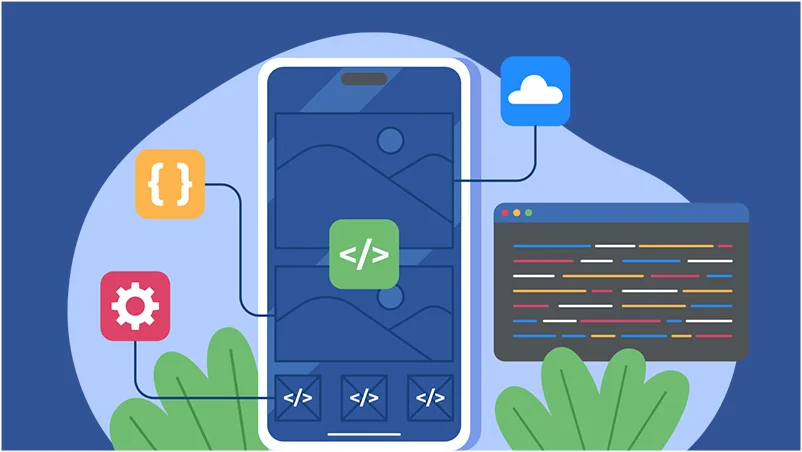Developing applications for healthcare or fintech tends to be inherently difficult as these industries are among the most heavily regulated. Compounding this problem is another barrier to entry, namely, user acceptance. The idea of using mobile applications to seek financial or healthcare services hasn’t caught on with the popular imagination. Startups bold enough to enter this market often face steep obstacles during the developmental stages that usually lead to business-crippling mistakes. However, cross platform app development has proven to help startups avoid those pitfalls and achieve growth.
So, if you’re an ambitious entrepreneur building a bootstrapped startup, or the CTO of a large corporation, this blog will help you navigate the dangers of mHealth and fintech landscapes using the multiplatform mobile app development approach.
Understanding The Mobile Application Landscape
There are over 5.2 million mobile applications on the Google Play Store and the Apple App Store combined. These applications are for everything ranging from booking movie tickets and making travel reservations to trading stocks and things as simple as setting alarms. However, an application is considered successful only when it surpasses the one million download mark. Only about 32,000 apps have achieved this milestone. That is just above 0.1% of all apps. This is not even considering the fact that about 99% of all apps eventually fail.
As brutal as the mobile application market is, the markets for fintech and mHealth (mobile health) apps are even worse, as healthcare and finance tend to be heavily regulated industries. Unlike consumer applications, these apps need to serve a very specific set of purposes and simultaneously provide a great user experience. Most people tend to shun the notion of applications for healthcare or financial services and prefer the old-fashioned route – going to a doctor for medical help or seeking professionals for financial advice.
The combination of strict government regulations and people’s reluctance makes it all more difficult for healthcare and fintech apps to succeed. This is on top of the inherent difficulty of succeeding in the mobile applications market in the first place.
Cross Platform App Development
Cross platform app development is nothing but a method of building mobile applications that are compatible with multiple operating systems. This approach is mainly aimed at the Android and iOS user bases, as these make up the near total app market. Moreover, the cross platform app development method uses a single programming language to build the app, which then works on both operating systems.

Technologies like React Native, Flutter, and Xamarin have revolutionized this space by providing the capacity to ‘write once, run anywhere.’ As the name suggests, these technologies eliminate the need for re-work and function just as well as on any platform.
Before we delve into the benefits of adopting the cross platform app development approach for healthcare and fintech, first, it’s necessary to discuss the pain points in that space.
The Challenges in Building mHealth and Fintech Applications
That the Cross Platform Approach Can Address
Startups, as well as established companies aiming to build apps for healthcare and fintech, face a set of challenges unique to their chosen vertical. Let’s take a look at some of the most common mistakes these organizations make and how cross-platform mobile app development can help.
Privacy and Security
Fintech and healthcare applications would routinely handle sensitive private information about its users. This would include details like personal banking data, transaction histories, portfolio details, medical background, and so forth. Needless to say, these applications make prime targets for cybercriminals, as personal data is extremely valuable.

Research has shown that up to 71% of medical applications have vulnerabilities. This number increases to 90% in the case of fintech applications. The COVID-19 pandemic increased the usage of mHealth apps manifold, and fintech applications have been witnessing a surge in their popularity thanks to an increase in the general interest surrounding personal finance. These factors contribute to creating a potential cybersecurity nightmare, as the data of tens of millions of users may be exposed to vulnerabilities.
A good way to mitigate many security risks involved in building these kinds of apps is to follow the cross platform app development method. The tools and technologies used in this approach maintain homogeneous security features across different platforms, making it easier for startups to manage security functions better. Being able to monitor and review a single codebase instead of multiple ones makes it faster and simpler to ascertain an app’s security features.
User Experience
No matter how many useful features an application packs, a confusing or overwhelming interface will make it cumbersome to use. The majority of users will eventually get frustrated, feel left out, and abandon the application. This goes on to increase the bounce rate, attracts mediocre reviews, and impacts your reputation. The user interface is the face of your app which is responsible for the very first impression. A good UI can become the key to user retention for your mobile app which cannot be ignored.
A user-friendly design, intuitive navigation, and seamless performance across platforms can be the pivotal factors between success and failure. Unfortunately, many startups, as well as established companies fail to deliver this consistency when developing separate apps for Android and iOS platforms. However, when companies follow the cross-platform app development approach, users are bound to get the same look and feel regardless of the operating system.
Development Costs and Time
Small, newly minted startups often lament the hemorrhage of money during application development. Between conceptualization, prototyping, development, testing, and deployment, funding seems to evaporate before anyone can do anything about it. The pressure to meet deadlines, be answerable to investors, manage recruitments, oversee development, carry out tests, and run advertisement campaigns combined put enormous strain on a company’s resources.
Creating separate applications for iOS and Android not only doubles the coding effort but also requires hiring skilled developers for each platform. This approach not only inflates the development budget but also prolongs the time-to-market. This duo of overstretched budget and increased time to deploy put together can cripple a startup financially.
A cross platform app development approach reduces the need to write unique code for each platform, leading to a cost-effective and efficient solution. By writing a single codebase, startups can expedite development, testing, and deployment, saving both time and money.
Additional Benefits of Multiplatform Mobile App Development
In addition to the most obvious advantages of pursuing a cross platform app development approach, here are some additional benefits:
Several Development Tools
Choosing to go with the cross platform app development approach provides an array of additional tools at the developers’ disposal. Some of these include Ionic, Titanium, PhoneGap/Cordova, and others, in addition to Xamarin and React Native. Each of these tools has its own set of advantages and presupposes the knowledge of certain programming skills. Developers need to carefully choose since it will lock them into a certain tech stack.
Uniform Look and Feel Across Platforms
Consistency in look and feel is basic to human nature, and mobile applications are no exception. Cross platform app development allows companies to track all aspects of their brand on mobile apps across all platforms to ensure that their target markets have consistent experiences. At the same time, cross platform development frameworks allow developers to create individual UI/UX for mobile applications according to the platform requirements.
Broader Outreach
The overwhelming majority of application users mainly use the Google Play Store or the Apple App Store. Other app stores make up a tiny portion of the app marketplace. Each store will tend to have a considerable marketing engine to help spread your message to its customers. The key is to provide value for all of them, and cross platform app development enables that.
Real-World Cross Platform App Development Success Stories
Numerous healthcare and fintech startups have adopted the cross platform approach for multiplatform mobile app development. It helped them to surmount the prevailing hurdles discussed above. Here are examples of a couple of them:
Fintech
Revolut is a global fintech company that offers a wide range of financial services. These include currency exchange, stock and commodities trading, crypto, debit and credit cards, and banking services, among others. Revolt’s cross platform mobile app stands as a testament to the power and versatility of this approach. It provides a secure, convenient, and consistent experience to users across both major platforms when handling their money.
Healthcare
MyTherapy Pill Reminder is an app that lets users be punctual about their medications. This app was built to address one of the major problems in US healthcare – the lack of adherence to prescriptions. According to the Centers for Disease Control and Prevention (CDC), over 40% of adults in the United States suffer from at least one chronic disease.
The lack of medication adherence is one of the biggest reasons for the worsening of chronic diseases in the country. MyTherapy Pill Reminder has helped millions of Americans stick to their medication regimens and manage their conditions better. The app provides a great user experience and serves its function perfectly on both Android and iOS operating systems.
Best Frameworks To Develop Cross Platform Mobile Apps
The surge in popularity of cross platform app development has been powered by a number of robust frameworks. These provide consistency, scalability, and efficiency across different platforms. Choosing the right one for your project requires knowledge of the unique attributes of each of these frameworks. So, let’s delve into the features of the most popular cross platform app development frameworks:
React Native
Unrolled by Meta (formerly Facebook), React Native is one of the most popular choices for multiplatform mobile app development. It allows developers to build high-performance apps in JavaScript while giving the feel of a native app. It lets developers build parts of an application in native code when necessary, enhancing performance.
React Native uses JSX, an XML-style syntax extension to JavaScript, and provides code that is both easy to write and understand.
Flutter
Flutter was developed by Google and is one of the most widely used cross platform app development frameworks in the world. It offers customizable widgets that aid in creating visually appealing apps. These widgets adhere to the design guidelines for each platform, providing a user experience similar to native apps.
Flutter uses the Dart programming language, which is object-oriented and facilitates excellent performance and rapid development.
Xamarin
Owned by none other than Microsoft, Xamarin brings .NET and C# to Android and iOS platforms. Xamarin integrates seamlessly with Visual Studio, a familiar, integrated development environment (IDE) for .NET developers. Xamarin.Forms engenders accelerated prototyping and facilitates easier cross platform app development through the use of reduced platform-specific functionalities.
onicI
Ionic is highly renowned among the global community of developers for its use in building high-performance cross platform mobile apps. It is built with Angular and Apache Cordova, enabling developers to build hybrid apps with familiar front-end technologies like HTML, CSS, and JavaScript. Ionic offers a comprehensive library of pre-built components that accelerate the development lifecycle significantly. It is becoming the go-to framework for cross platform app development activities.
Conclusion
Cross platform app development is not just one of the many passing trends; it is a viable strategy for success in app development. At a time when funding for startups across the globe is drying up, choosing the cross platform approach for mobile app development provides a considerable advantage. The Covid-19 pandemic left a high demand for mHealth and personal finance in its wake. Ambitious startups aiming to capitalize on this opportunity should consider every advantage available.
FlatworldEdge is a leading provider of tailored software solutions. Our mobile app development services have served clients across three continents. We analyze your requirements and create customized apps on Android and iOS platforms. Are you struggling to build apps that are platform-agnostic? Call us today for the best cross platform app development services to accelerate the time to market and establish your presence.




